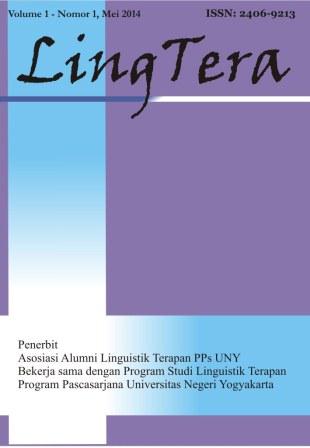The construction of modalities in Indonesian and English folktales
DOI:
https://doi.org/10.21831/lt.v11i2.69564Keywords:
modality expression, epistemic modality, deontic modality, folktalesAbstract
References
Biber, D., Johansson, S., Leech, G., Conrad, S., & Finegan, E. (1999). Longman grammar of spoken and written English. Pearson Education Limited.
Bybee, J., & Perkins, R. (1994). Mood and modality in the evolution of grammar: Tense, aspect, and modality in the languages of the world. University of Chicago Press.
Cubitt, C. (2006). Folklore and historiography: Oral stories and the writing of Anglo-Saxon history. In E. M. Tyler & R. Balzaretti (Eds.), Narrative and history in the Early Medieval West (pp. 189–224). Brepols Publishers.
Coates, J. (1983). The semantics of the modal auxiliaries. Croom Helm.
Dorson, R. M. (1963). Current folklore theories. Current Anthropology, 4(1), 93–112.
von Fintel, K. (2006). Modality and language. In D. M. Borchert (Ed.), Encyclopedia of Philosophy (2nd ed.). Macmillan Reference. http://mit.edu/fintel/fintel-2006-modality.pdf
Frawley, W. (1992). Linguistic semantics. Routledge.
Halliday, M. A. K. (1994). An introduction to functional grammar. Edward Arnold.
Halliday, M. A. K., & Hasan, R. (1985). Language, context, and text: Aspects of language in a social-semiotic perspective. Deakin University Press.
Huddleston, Rodney and Pullum, Geoffrey. (2002). The Cambridge Grammar of English. Cambridge: Cambridge University Press.
He, Y., & Wang, H. (2013). A corpus-based study of epistemic modality markers in Chinese research articles. Lecture Notes in Computer Science, 7717, 199–208.
Hinkel, E. (2002). Second language writers' text: Linguistic and rhetorical features. Lawrence Erlbaum Associates.
Krasniqi. (2019). The relation between language and culture: Case study Albanian language. Linguistics and Literature Studies, 7(2), 71–74. http://www.hrpub.com
Kramsch, C. (1998). Language and culture. Oxford University Press.
Khamkhien, A. (2021). Adjectives in the expression of epistemic modality in applied linguistics research articles. Language Literacy: Journal of Linguistics, Literature and Language Teaching, 5(2), 431–452.
Khoshsima, H., Baghsiahi, A., & Moafian, F. (2016). A cross-linguistic and cross-cultural study of epistemic modality markers in linguistics research articles. Iranian Journal of English for Academic Purposes, 5(2), 102–122.
Kratzer, A. (1981). The notion category of modality. In H. J. Eikmeyer & H. Rieser (Eds.), Worlds, words, and contexts (pp. 38–74). De Gruyter.
Kreidler, C. W. (1998). Introducing English semantics. Routledge.
Lyons, J. (1977). Semantics. Cambridge University Press.
Lwin, S. M. (2015). Using folktales for language teaching. The English Teacher, 44(2), 74–83.
Mantra, I. B. N. (2017). Promoting students' writing skill through folktales-based learning activities. ISOLEC Proceedings. Faculty of Letters, Universitas Negeri Malang.
Mphasha, L. E. (2017). Folktales reveal the cultural values of the community: A SWOT (Strengths, Weaknesses, Opportunities, and Threats) analysis. The Anthropologist, 19(1), 295–302.
Mantra, I. B. N., & Kumara. (2018). Folktales as meaningful cultural and linguistic resources to improve students' reading skills. Lingua Scientia Journal, 25(2), 83–88.
Nuyts, J. (2006). Modality: Overview and linguistic issues. In W. Frawley (Ed.), The expressions of modality (pp. 1–26). Mouton de Gruyter.
Nhat, T. N., & Minh, N. T. (2020). A study on modality in English-medium research articles. Journal of Foreign Studies, 36(6), 74–92.
Nursanti, E. (2022). Mood structures and their functions to reveal white's dominance: A critical discourse analysis in Doris Lessing's The Grass is Singing. LingTera, 9(1), 1–13.
Orta, I. V. (2010). A contrastive analysis of the use of modal verbs in the expression of epistemic stance in business management research articles in English and Spanish. Iberica, 19, 77–96.
Propp, V. (1968). Morphology of the folktale. American Folklore Society.
Palmer, F. R. (1986). Mood and modality. Cambridge University Press.
Palmer, F. R. (2003). Modality in English. In R. Facchinetti, M. Krug, & F. Palmer (Eds.), Modality in contemporary English (pp. 1–17). Mouton de Gruyter.
Papafragou, A. (2000). Modality: Issues in the semantics-pragmatics interface. Elsevier.
Portner, P. (2009). Modality. Oxford University Press.
Quirk, R., Greenbaum, S., Leech, G., & Svartvik, J. (1985). A comprehensive grammar of the English language. Longman.
Ragan, K. (2009). What happened to the heroines in folktales? An analysis by gender of a multicultural sample of published folktales collected from storytellers. Marvels & Tales, 23(2), 227–247.
Ryspayeva, D., Kuzmina, T., & Atanov, R. (2018). Multicultural space: The study of Kazakhstan folklore. IJASOS-International E-Journal of Advances in Social Sciences, 4(12), 843–851.
Shiro, M. (2004). The expressions of epistemic modality and the construction of narrative stance in Venezuelan children's stories. Psychology of Language and Communication, 8(2), 35–56.
Saeed, J. I. (2009). Semantics. Wiley-Blackwell Publishing Ltd.
Surjowati, R. (2016). Revealing power and ideology through modality expressions in Australian newspaper reporting on JIS's pedophilia. Proceedings of the International Conference on Language and Communication, 630–635.
Surjowati, R. (2016). Modality meanings in students' argumentative writing. Proceedings of the International Conference on Language and Communication, 196–201.
Stockwell, R., Bowen, J. D., & Martin, J. W. (1965). The grammatical structures of English and Spanish. University of Chicago Press.
Simpson, P. (1994). Stylistics: A resource book for students. Routledge.
Sunardi. (2013). Modality realizations in a cross-cultural casual conversation: A systemic functional linguistics perspective. UNS Journal of Language Studies, 2(1), 68–80.
Trask, R. L. (2007). Language and linguistics: The key concepts (2nd ed.). Routledge.
Tran, T. B. (2022). A cross-cultural study of modality in the speech act of asking permission. Theory and Practice in Language Studies, 12(5), 854–865.
Taylor, E. K. (2000). Using folktales. Cambridge University Press.
Touriño, A. V. (2002). Dynamic modality: English and Spanish contrasted. Proceedings of the 2nd International Contrastive Linguistics Conference, 1041–1050.
Downloads
Published
How to Cite
Issue
Section
Citation Check
License
LingTera allows readers to read, download, copy, distribute, print, search, or link to its articles' full texts and allows readers to use them for any other lawful purpose. The journal allows the author(s) to hold the copyright without restrictions. Finally, the journal allows the author(s) to retain publishing rights without restrictions.
- Authors are allowed to archive their submitted articles in an open-access repository.
- Authors are allowed to archive the final published article in an open-access repository with an acknowledgment of its initial publication in this journal.

Psychology, Evaluation, and Technology in Educational Research is licensed under a Creative Commons Attribution-ShareAlike 4.0 International License.
Based on a work at https://petier.org/index.php/PETIER.









